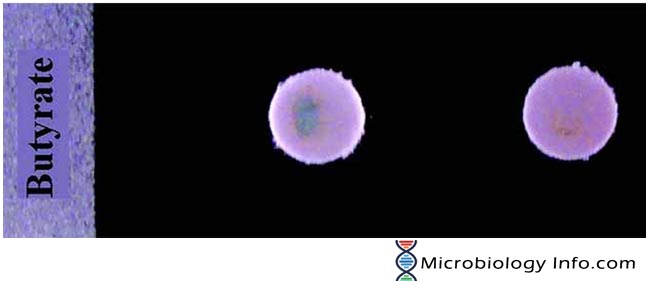- Butyrate discs are employed in the microbiology lab for demonstrating the enzymatic hydrolysis of bromo-chloro-indolyl butyrate.
- The Test Disc is used for rapid detection and qualitative procedures of butyrate esterase for presumptive identification of Moraxella catarrhalis.
- Moraxella catarrhalis is recognized as a significant pathogen whose isolation from routine sputum cultures is associated with clinical infection.
- The rapid identification of this organism is important, since most strains produce beta-lactamase and are resistant to penicillin and ampicillin.
- Conventional methods of identification may take up to 48 hours to perform while the detection of an enzyme, butyrate esterase, is a rapid means of identifying Moraxella catarrhalis, which is performed using butyrate discs.
Objectives
To detect the enzyme butyrate esteraste in microorganisms
Principle
Organisms capable of producing butyrate esterase hydrolyze bromochlorindolyl butyrate. Disks impregnated with bromo-chloro-indolyl butyrate serve as the substrate for the detection of butyrate esterase. Hydrolysis of the substrate in the presence of butyrate esterase releases indoxyl, which in the presence of oxygen spontaneously forms indigo, a blue to blue-violet color.
Method
- Remove a disk from the vial and place on a glass microscope slide.
- Add 1 drop of reagent-grade water. This should leave a slight excess of water on the disk.
- Using a wooden applicator stick, rub a small amount of several colonies from an 18- to 24-hour pure culture onto the disk.
- Incubate at room temperature for up to 5 minutes.
Expected Results
Positive: Development of a blue color during the 5-minute incubation period.
Negative: No color change.
Uses
- Aid in the identification of Moraxella (Branhamella) catarrhalis.
- Helps to differentiate Neisseria gonorrhoeae(negative) and Moraxella catarrhalis(positive), which are both Oxidase positive, Gram negative diplococci.
Limitations
- Incubation longer than 5 minutes may result in a false-positive reaction.
- False-negative reactions may also occur if the inoculum is too small.
- Test should be performed in conjunction with chromogenic substrate tests or carbohydrate fermentations, oxidase reaction, Gram stain and morphology for complete identification.
- Non-human species of Branhamella subgenus Moraxella are butyrate esterase-positive.
- Some strains of the subgenus Moraxella (bacilli) may give a positive or weak positive reaction.
- Unrelated organisms such as staphylococci and pseudomonads may also give positive results.
References
- Tille, P. M., & Forbes, B. A. (2014). Bailey & Scott’s diagnostic microbiology (Thirteenth edition.). St. Louis, Missouri: Elsevier.
- https://www.thermofisher.com/order/catalog/product/R21121
- https://catalog.hardydiagnostics.com/cp_prod/content/hugo/CatScreen.htm
- https://www.keyscientific.com/BUTYRATE-DISCS-differentiate-Branhamella-Catarrhalis-from-Neisseria-spp.-by-demonstrating-the-enzymatic-hydrolysis-of-bromo-chloro-indolyl-butyrate.-50-discs.html

